Environmental Control Systems in Buildings: Council House 2 Case Study
VerifiedAdded on 2023/05/30
|17
|2777
|427
Report
AI Summary
This report presents a comprehensive case study of Council House 2, focusing on its innovative environmental control systems. The building, located in Melbourne, Australia, employs various sustainable design strategies, including bioclimatic design principles inspired by termite mounds and the use of natural convection, thermal mass, and ventilation stacks. The report details the building's facade design, which incorporates an epidermis and dermis for micro-environmental control, as well as strategies for natural daylighting through light shelves, vaulted ceilings, and timber louvers. Furthermore, the report examines the use of radiant cooling, phase change materials, and displacement ventilation. The performance analysis includes calculations for solar heat gain and peak heat loss, providing insights into the building's energy efficiency. The report also covers innovative features like shower towers and roof gardens, emphasizing the building's commitment to sustainability and employee well-being.
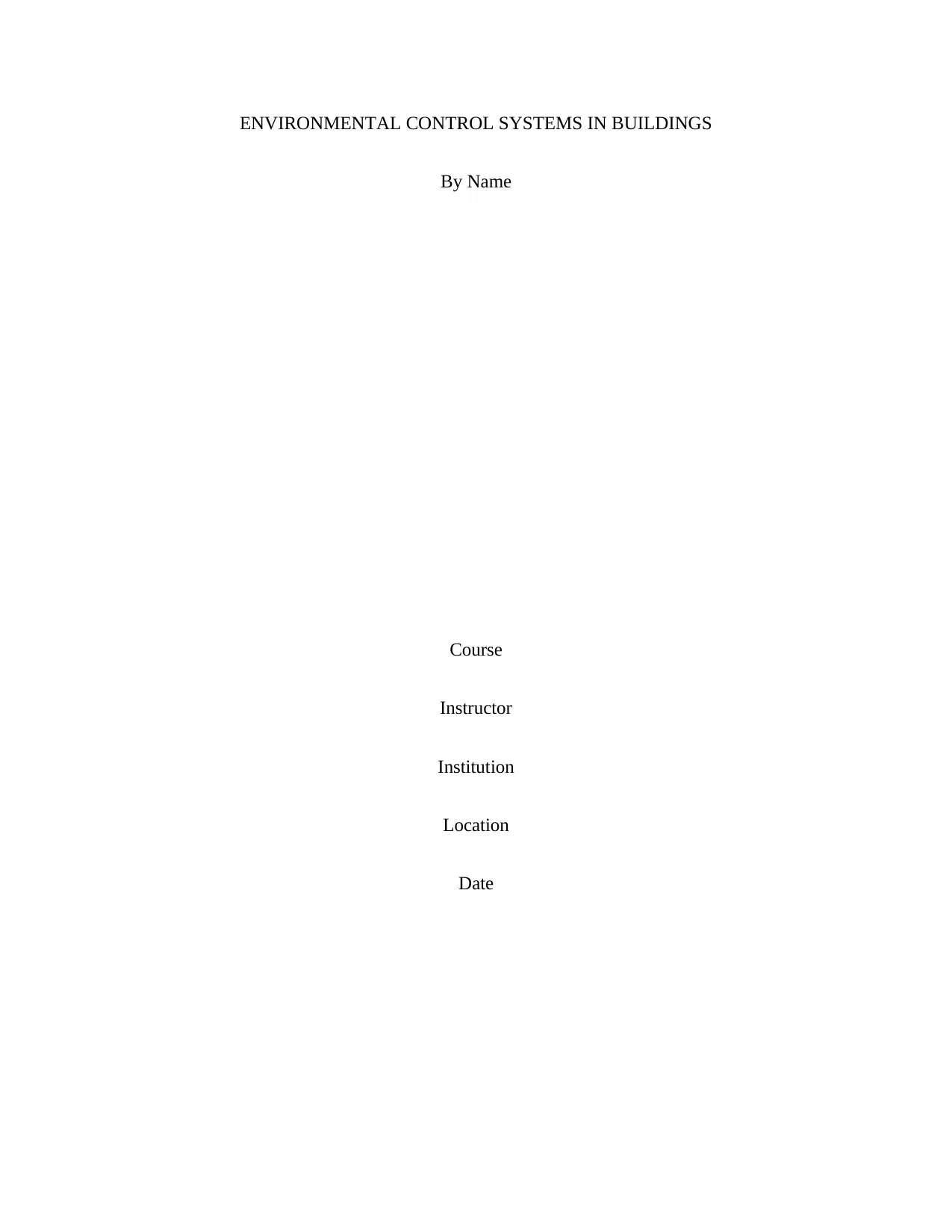
ENVIRONMENTAL CONTROL SYSTEMS IN BUILDINGS
By Name
Course
Instructor
Institution
Location
Date
By Name
Course
Instructor
Institution
Location
Date
Paraphrase This Document
Need a fresh take? Get an instant paraphrase of this document with our AI Paraphraser

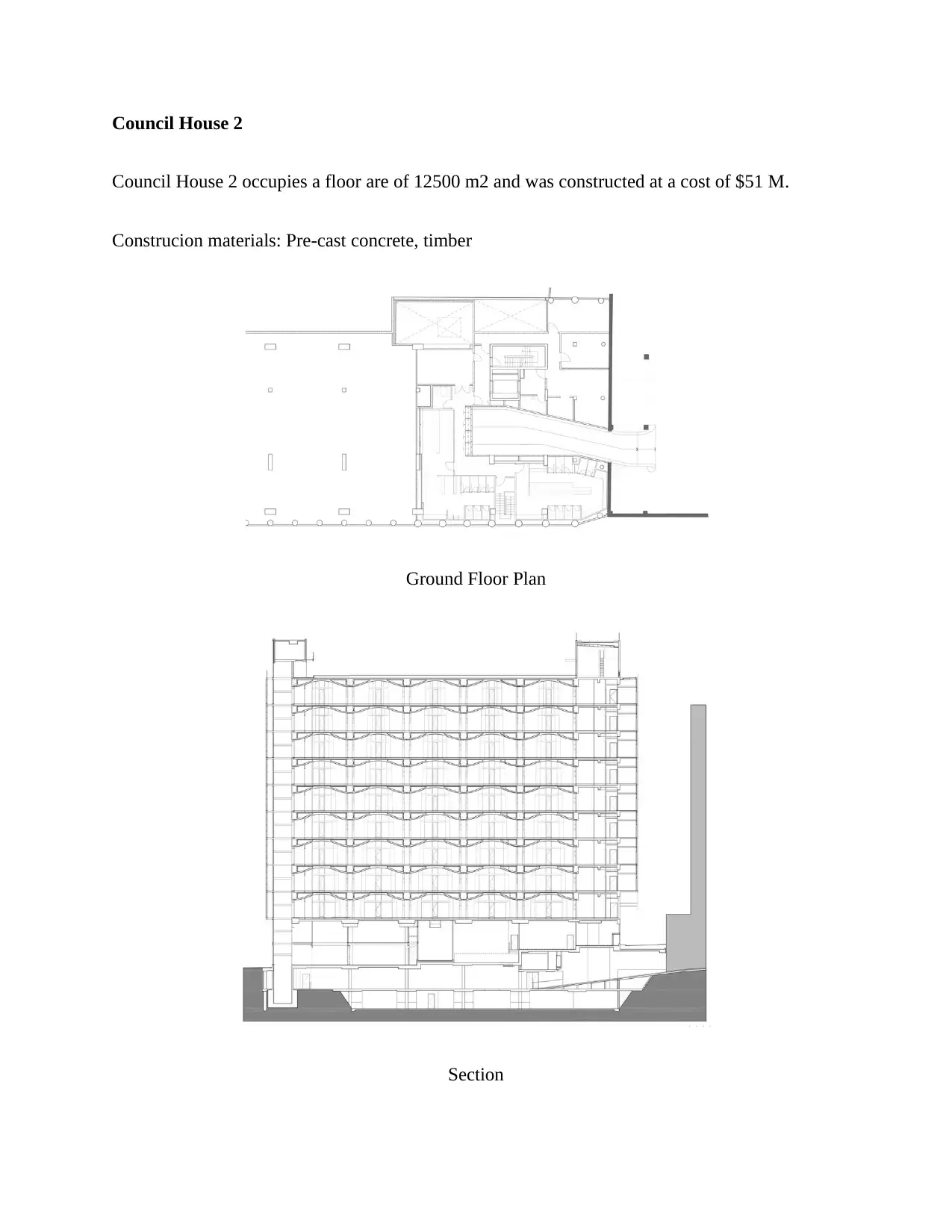
Council House 2
Council House 2 occupies a floor are of 12500 m2 and was constructed at a cost of $51 M.
Construcion materials: Pre-cast concrete, timber
Ground Floor Plan
Section
Council House 2 occupies a floor are of 12500 m2 and was constructed at a cost of $51 M.
Construcion materials: Pre-cast concrete, timber
Ground Floor Plan
Section
⊘ This is a preview!⊘
Do you want full access?
Subscribe today to unlock all pages.

Trusted by 1+ million students worldwide
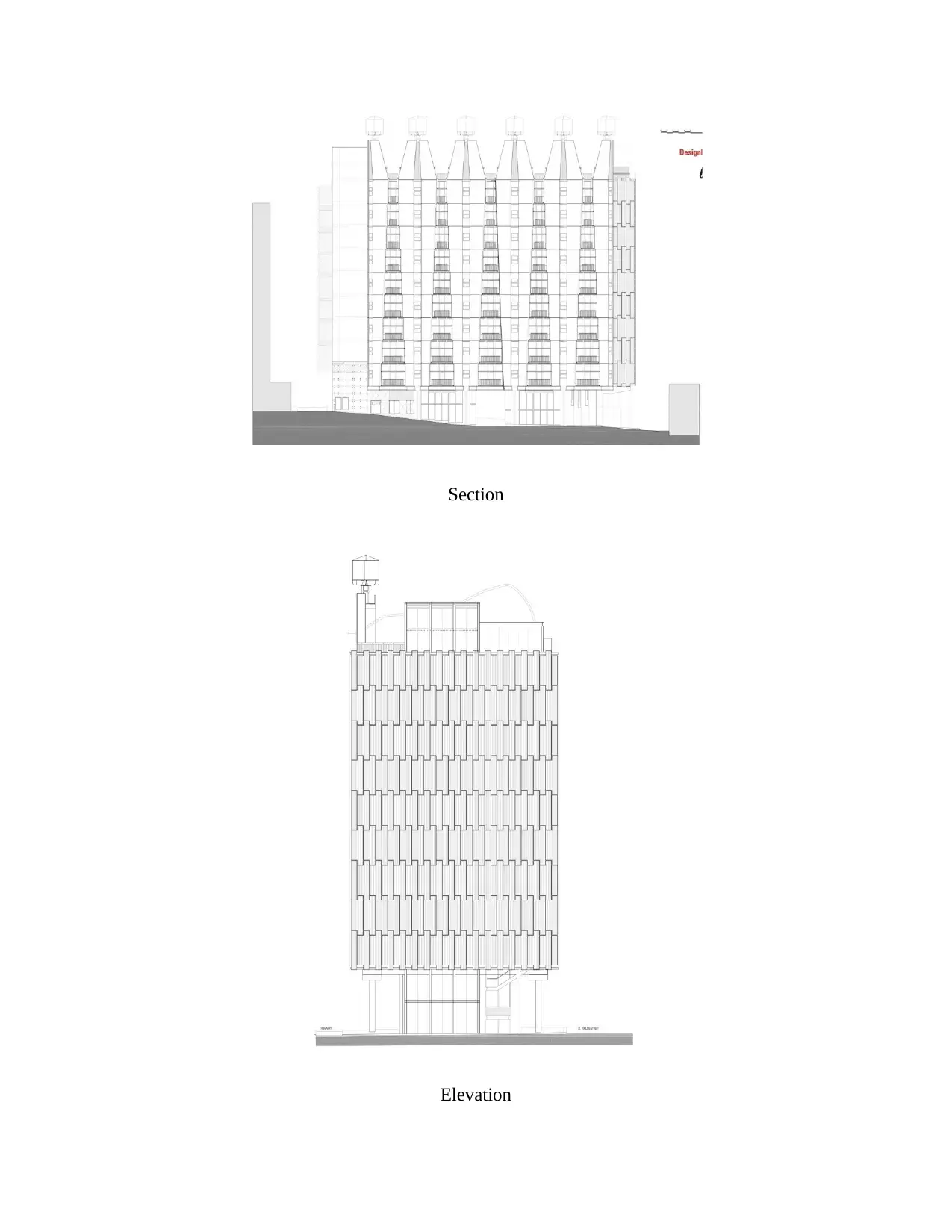
Section
Elevation
Elevation
Paraphrase This Document
Need a fresh take? Get an instant paraphrase of this document with our AI Paraphraser
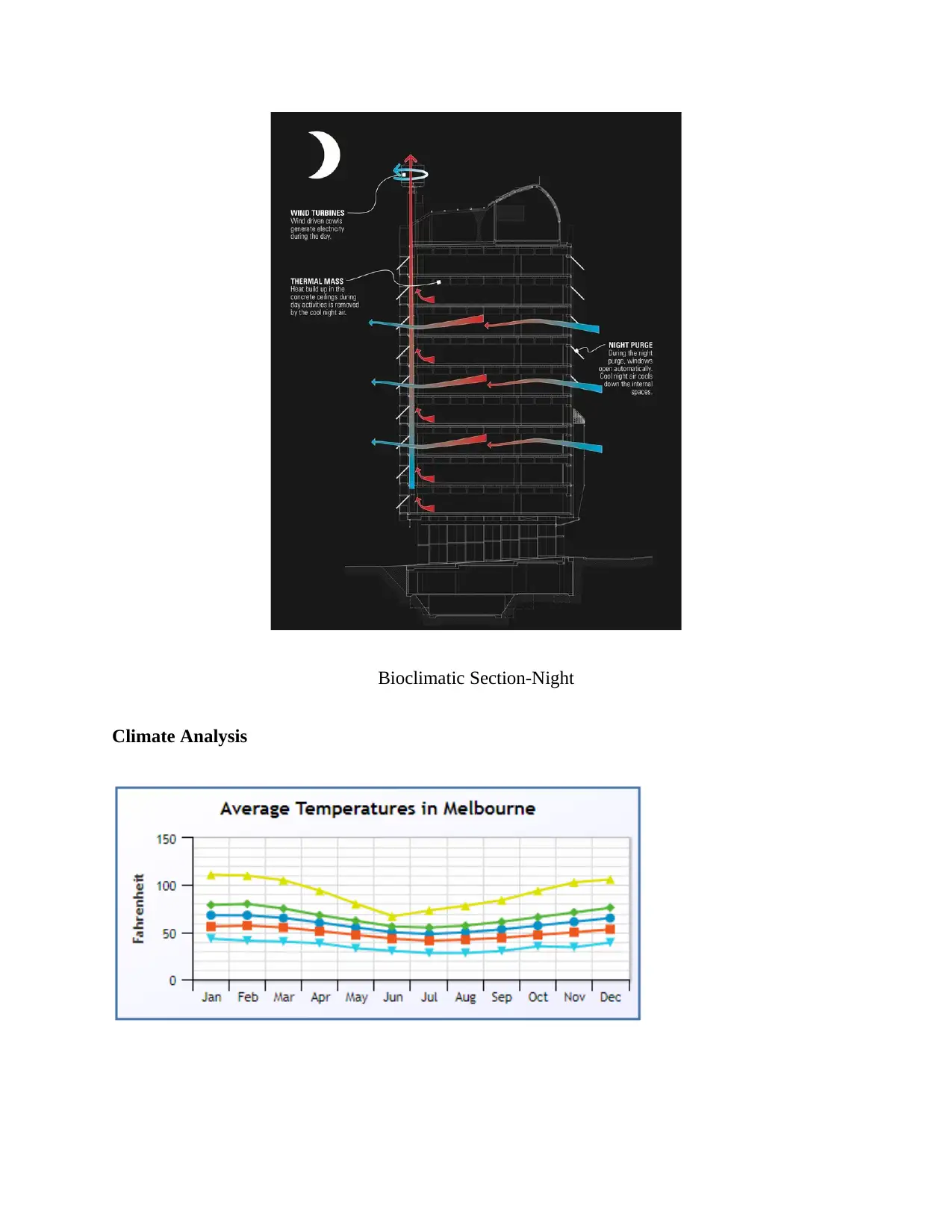
Bioclimatic Section-Night
Climate Analysis
Climate Analysis

The climate of Melbourne where the building is located is subtropical oceanic and has pleasantly
warm summers as well as mild winters. The weather is mostly variable owing to the fact that the
city is situated enough to the south to be influenced by the flow of the westerly winds that bring
low pressure systems for numerous months a year (Afram and Janabi-Sharifi, 2014).
Rainfall is not as abundant in Melbourne as it adds up to 650 ml which is about 25.5 inches even
though it is properly distributed over the seasons of the year in such a way that there is no real
dry season. Nonetheless, the least rainy season is often experienced during summers.
In as much as it is having mild climate, Melbourne is often subject to swings in climate since it is
reachable by both the masses of cold air from the sea that surround Antarctica as well as by the
dry and hot air masses from the Australian desert (Aghemo, Blaso and Pellegrino, 2014). The
winds in the region are often frequent as the westerlies normally blow for the most days of the
year while during summer when it is sunny the flow of the sea breeze is often in the afternoon.
Not by coincidence, around Melbourne there are numerous beaches frequented by surfers.
warm summers as well as mild winters. The weather is mostly variable owing to the fact that the
city is situated enough to the south to be influenced by the flow of the westerly winds that bring
low pressure systems for numerous months a year (Afram and Janabi-Sharifi, 2014).
Rainfall is not as abundant in Melbourne as it adds up to 650 ml which is about 25.5 inches even
though it is properly distributed over the seasons of the year in such a way that there is no real
dry season. Nonetheless, the least rainy season is often experienced during summers.
In as much as it is having mild climate, Melbourne is often subject to swings in climate since it is
reachable by both the masses of cold air from the sea that surround Antarctica as well as by the
dry and hot air masses from the Australian desert (Aghemo, Blaso and Pellegrino, 2014). The
winds in the region are often frequent as the westerlies normally blow for the most days of the
year while during summer when it is sunny the flow of the sea breeze is often in the afternoon.
Not by coincidence, around Melbourne there are numerous beaches frequented by surfers.
⊘ This is a preview!⊘
Do you want full access?
Subscribe today to unlock all pages.

Trusted by 1+ million students worldwide
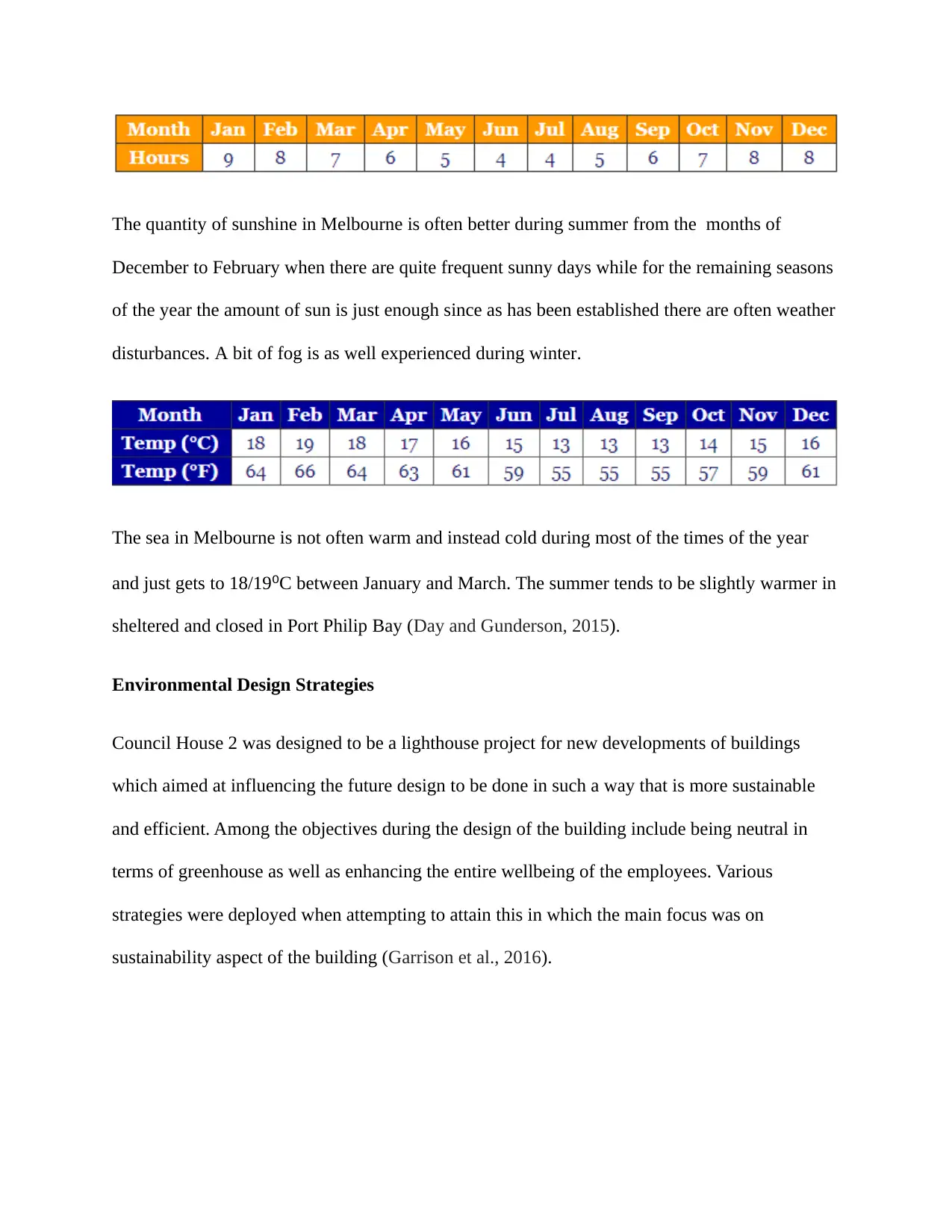
The quantity of sunshine in Melbourne is often better during summer from the months of
December to February when there are quite frequent sunny days while for the remaining seasons
of the year the amount of sun is just enough since as has been established there are often weather
disturbances. A bit of fog is as well experienced during winter.
The sea in Melbourne is not often warm and instead cold during most of the times of the year
and just gets to 18/19⁰C between January and March. The summer tends to be slightly warmer in
sheltered and closed in Port Philip Bay (Day and Gunderson, 2015).
Environmental Design Strategies
Council House 2 was designed to be a lighthouse project for new developments of buildings
which aimed at influencing the future design to be done in such a way that is more sustainable
and efficient. Among the objectives during the design of the building include being neutral in
terms of greenhouse as well as enhancing the entire wellbeing of the employees. Various
strategies were deployed when attempting to attain this in which the main focus was on
sustainability aspect of the building (Garrison et al., 2016).
December to February when there are quite frequent sunny days while for the remaining seasons
of the year the amount of sun is just enough since as has been established there are often weather
disturbances. A bit of fog is as well experienced during winter.
The sea in Melbourne is not often warm and instead cold during most of the times of the year
and just gets to 18/19⁰C between January and March. The summer tends to be slightly warmer in
sheltered and closed in Port Philip Bay (Day and Gunderson, 2015).
Environmental Design Strategies
Council House 2 was designed to be a lighthouse project for new developments of buildings
which aimed at influencing the future design to be done in such a way that is more sustainable
and efficient. Among the objectives during the design of the building include being neutral in
terms of greenhouse as well as enhancing the entire wellbeing of the employees. Various
strategies were deployed when attempting to attain this in which the main focus was on
sustainability aspect of the building (Garrison et al., 2016).
Paraphrase This Document
Need a fresh take? Get an instant paraphrase of this document with our AI Paraphraser
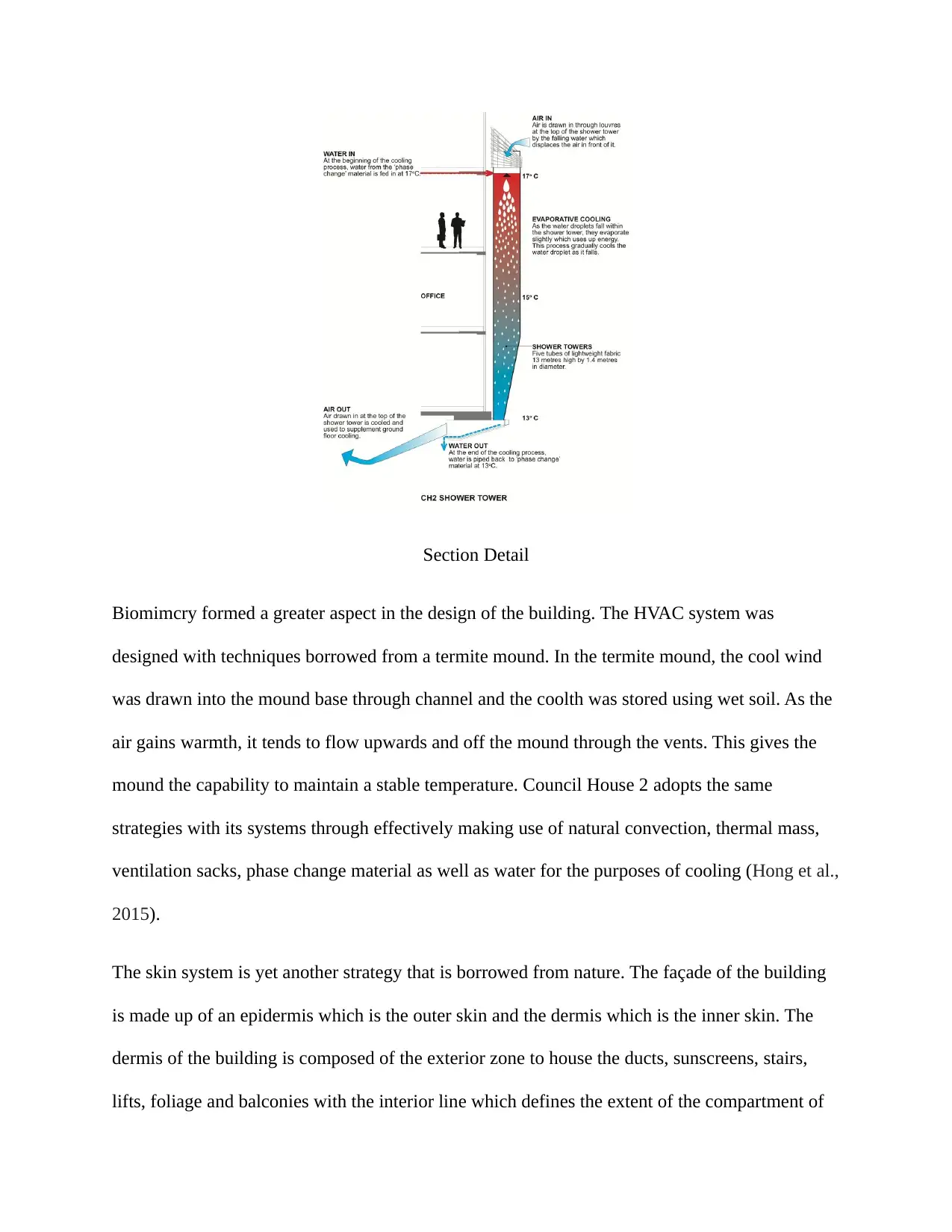
Section Detail
Biomimcry formed a greater aspect in the design of the building. The HVAC system was
designed with techniques borrowed from a termite mound. In the termite mound, the cool wind
was drawn into the mound base through channel and the coolth was stored using wet soil. As the
air gains warmth, it tends to flow upwards and off the mound through the vents. This gives the
mound the capability to maintain a stable temperature. Council House 2 adopts the same
strategies with its systems through effectively making use of natural convection, thermal mass,
ventilation sacks, phase change material as well as water for the purposes of cooling (Hong et al.,
2015).
The skin system is yet another strategy that is borrowed from nature. The façade of the building
is made up of an epidermis which is the outer skin and the dermis which is the inner skin. The
dermis of the building is composed of the exterior zone to house the ducts, sunscreens, stairs,
lifts, foliage and balconies with the interior line which defines the extent of the compartment of
Biomimcry formed a greater aspect in the design of the building. The HVAC system was
designed with techniques borrowed from a termite mound. In the termite mound, the cool wind
was drawn into the mound base through channel and the coolth was stored using wet soil. As the
air gains warmth, it tends to flow upwards and off the mound through the vents. This gives the
mound the capability to maintain a stable temperature. Council House 2 adopts the same
strategies with its systems through effectively making use of natural convection, thermal mass,
ventilation sacks, phase change material as well as water for the purposes of cooling (Hong et al.,
2015).
The skin system is yet another strategy that is borrowed from nature. The façade of the building
is made up of an epidermis which is the outer skin and the dermis which is the inner skin. The
dermis of the building is composed of the exterior zone to house the ducts, sunscreens, stairs,
lifts, foliage and balconies with the interior line which defines the extent of the compartment of
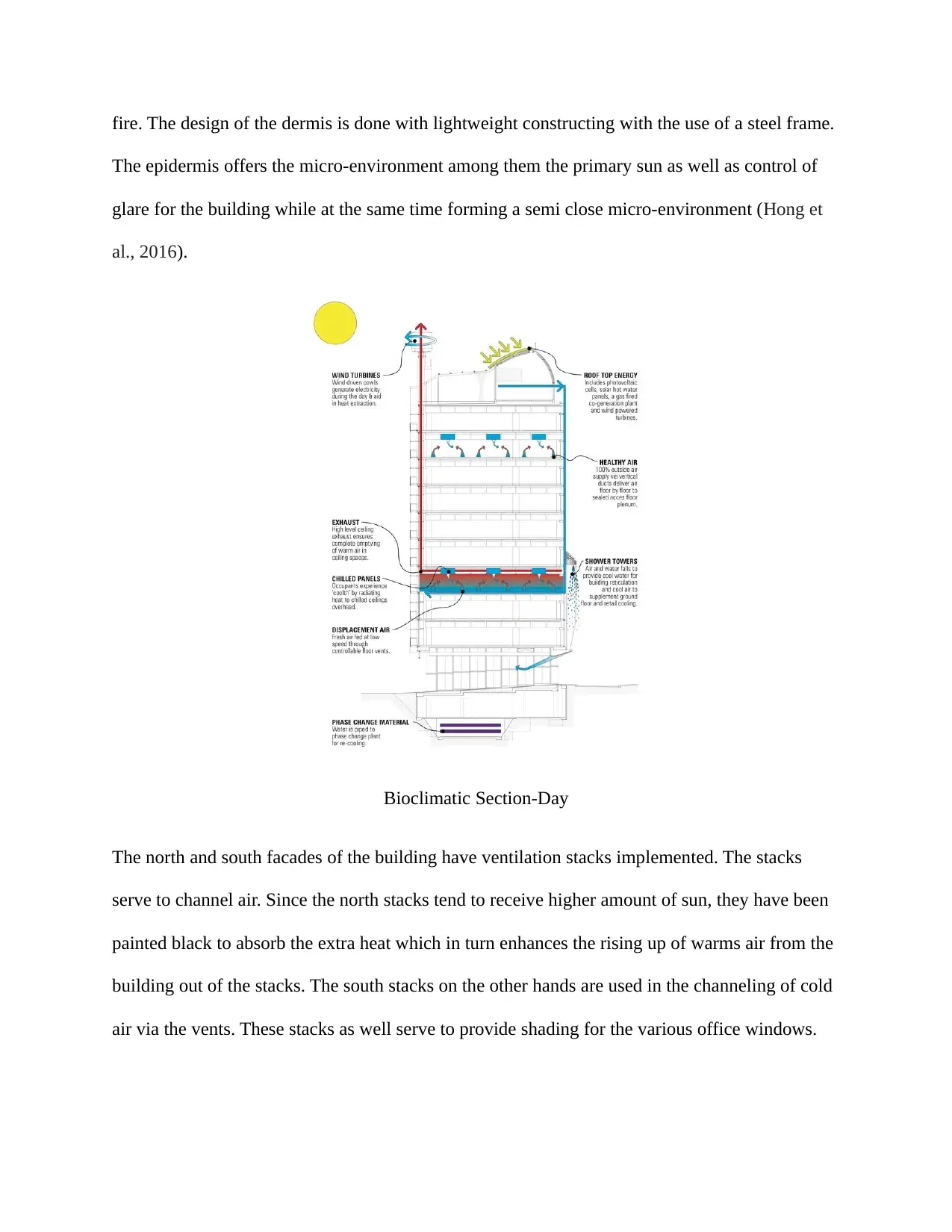
fire. The design of the dermis is done with lightweight constructing with the use of a steel frame.
The epidermis offers the micro-environment among them the primary sun as well as control of
glare for the building while at the same time forming a semi close micro-environment (Hong et
al., 2016).
Bioclimatic Section-Day
The north and south facades of the building have ventilation stacks implemented. The stacks
serve to channel air. Since the north stacks tend to receive higher amount of sun, they have been
painted black to absorb the extra heat which in turn enhances the rising up of warms air from the
building out of the stacks. The south stacks on the other hands are used in the channeling of cold
air via the vents. These stacks as well serve to provide shading for the various office windows.
The epidermis offers the micro-environment among them the primary sun as well as control of
glare for the building while at the same time forming a semi close micro-environment (Hong et
al., 2016).
Bioclimatic Section-Day
The north and south facades of the building have ventilation stacks implemented. The stacks
serve to channel air. Since the north stacks tend to receive higher amount of sun, they have been
painted black to absorb the extra heat which in turn enhances the rising up of warms air from the
building out of the stacks. The south stacks on the other hands are used in the channeling of cold
air via the vents. These stacks as well serve to provide shading for the various office windows.
⊘ This is a preview!⊘
Do you want full access?
Subscribe today to unlock all pages.

Trusted by 1+ million students worldwide
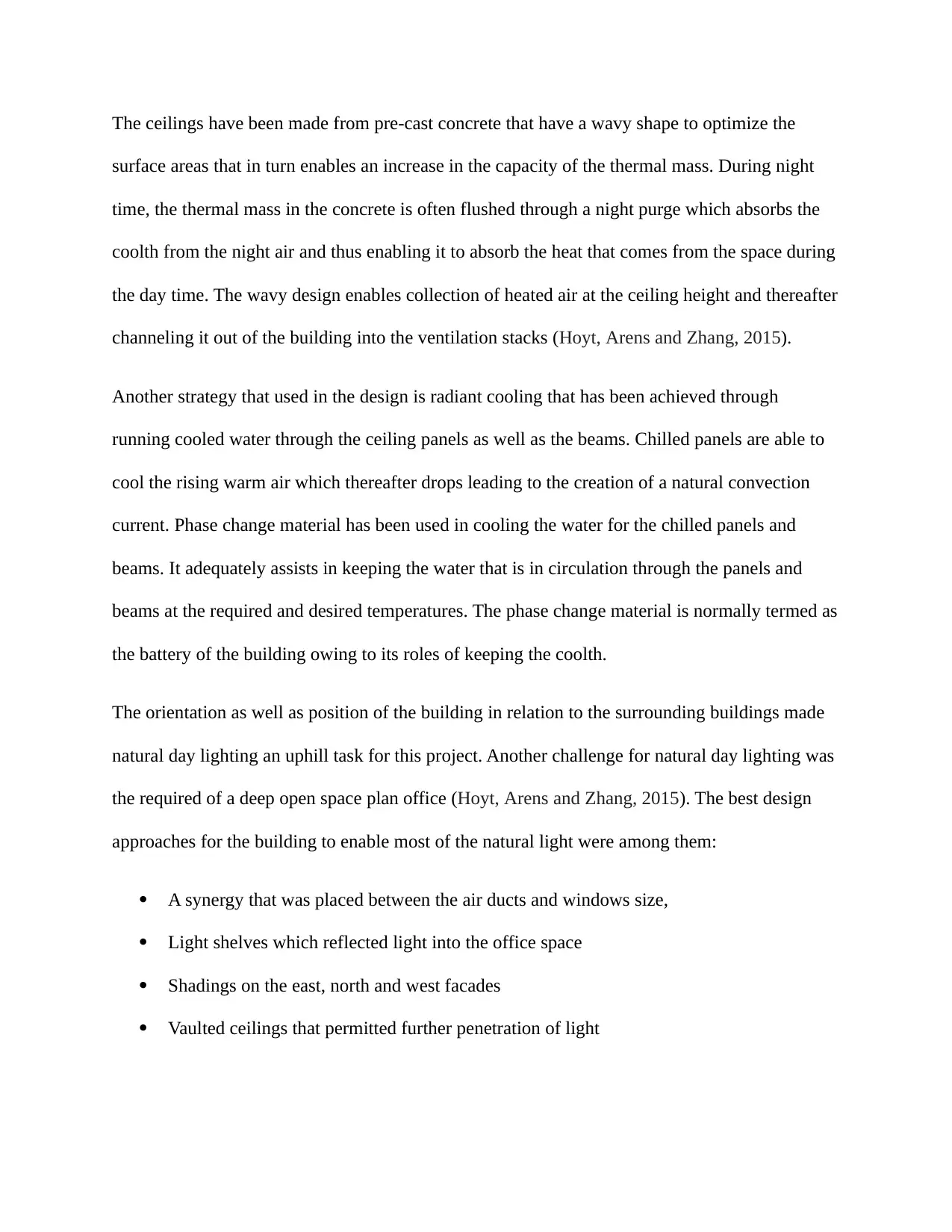
The ceilings have been made from pre-cast concrete that have a wavy shape to optimize the
surface areas that in turn enables an increase in the capacity of the thermal mass. During night
time, the thermal mass in the concrete is often flushed through a night purge which absorbs the
coolth from the night air and thus enabling it to absorb the heat that comes from the space during
the day time. The wavy design enables collection of heated air at the ceiling height and thereafter
channeling it out of the building into the ventilation stacks (Hoyt, Arens and Zhang, 2015).
Another strategy that used in the design is radiant cooling that has been achieved through
running cooled water through the ceiling panels as well as the beams. Chilled panels are able to
cool the rising warm air which thereafter drops leading to the creation of a natural convection
current. Phase change material has been used in cooling the water for the chilled panels and
beams. It adequately assists in keeping the water that is in circulation through the panels and
beams at the required and desired temperatures. The phase change material is normally termed as
the battery of the building owing to its roles of keeping the coolth.
The orientation as well as position of the building in relation to the surrounding buildings made
natural day lighting an uphill task for this project. Another challenge for natural day lighting was
the required of a deep open space plan office (Hoyt, Arens and Zhang, 2015). The best design
approaches for the building to enable most of the natural light were among them:
A synergy that was placed between the air ducts and windows size,
Light shelves which reflected light into the office space
Shadings on the east, north and west facades
Vaulted ceilings that permitted further penetration of light
surface areas that in turn enables an increase in the capacity of the thermal mass. During night
time, the thermal mass in the concrete is often flushed through a night purge which absorbs the
coolth from the night air and thus enabling it to absorb the heat that comes from the space during
the day time. The wavy design enables collection of heated air at the ceiling height and thereafter
channeling it out of the building into the ventilation stacks (Hoyt, Arens and Zhang, 2015).
Another strategy that used in the design is radiant cooling that has been achieved through
running cooled water through the ceiling panels as well as the beams. Chilled panels are able to
cool the rising warm air which thereafter drops leading to the creation of a natural convection
current. Phase change material has been used in cooling the water for the chilled panels and
beams. It adequately assists in keeping the water that is in circulation through the panels and
beams at the required and desired temperatures. The phase change material is normally termed as
the battery of the building owing to its roles of keeping the coolth.
The orientation as well as position of the building in relation to the surrounding buildings made
natural day lighting an uphill task for this project. Another challenge for natural day lighting was
the required of a deep open space plan office (Hoyt, Arens and Zhang, 2015). The best design
approaches for the building to enable most of the natural light were among them:
A synergy that was placed between the air ducts and windows size,
Light shelves which reflected light into the office space
Shadings on the east, north and west facades
Vaulted ceilings that permitted further penetration of light
Paraphrase This Document
Need a fresh take? Get an instant paraphrase of this document with our AI Paraphraser
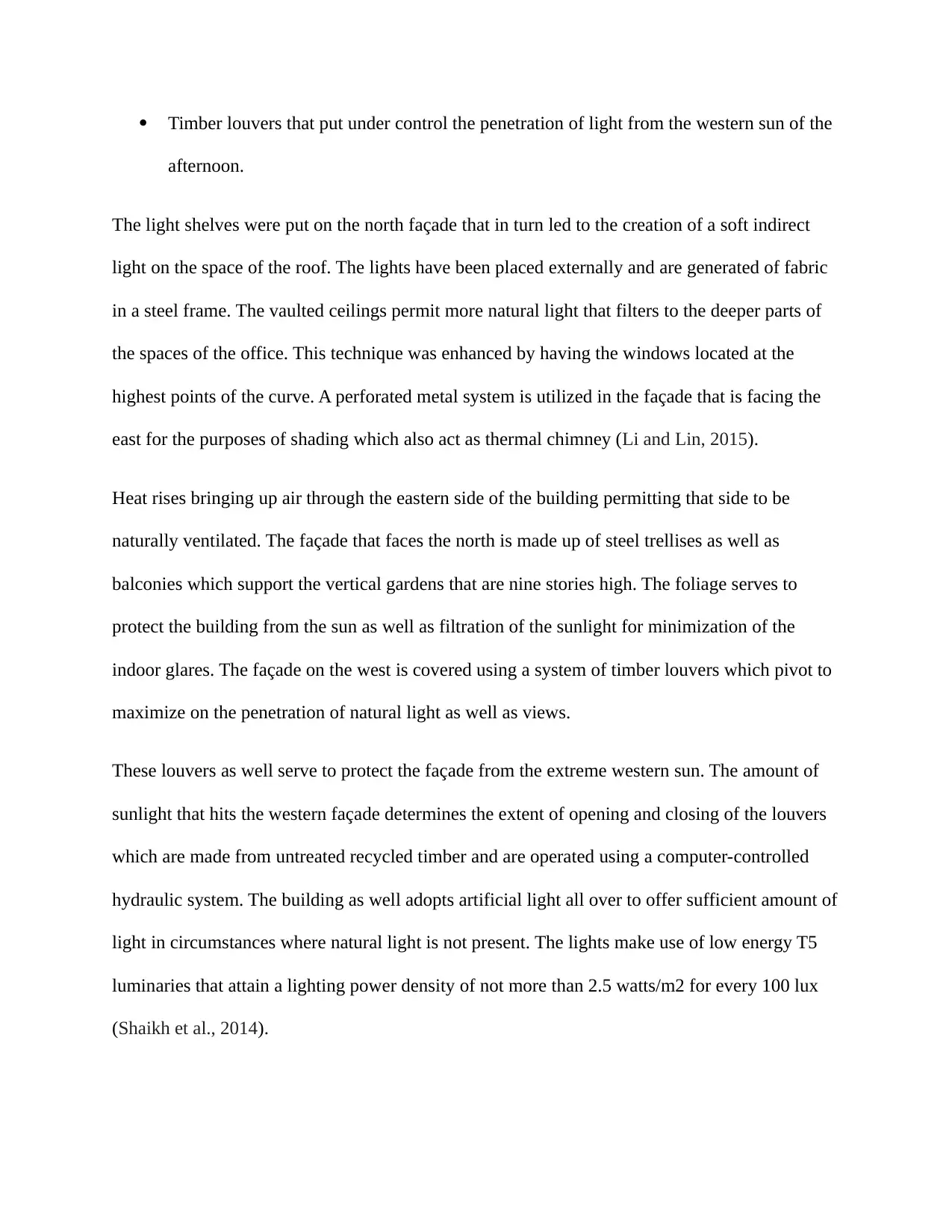
Timber louvers that put under control the penetration of light from the western sun of the
afternoon.
The light shelves were put on the north façade that in turn led to the creation of a soft indirect
light on the space of the roof. The lights have been placed externally and are generated of fabric
in a steel frame. The vaulted ceilings permit more natural light that filters to the deeper parts of
the spaces of the office. This technique was enhanced by having the windows located at the
highest points of the curve. A perforated metal system is utilized in the façade that is facing the
east for the purposes of shading which also act as thermal chimney (Li and Lin, 2015).
Heat rises bringing up air through the eastern side of the building permitting that side to be
naturally ventilated. The façade that faces the north is made up of steel trellises as well as
balconies which support the vertical gardens that are nine stories high. The foliage serves to
protect the building from the sun as well as filtration of the sunlight for minimization of the
indoor glares. The façade on the west is covered using a system of timber louvers which pivot to
maximize on the penetration of natural light as well as views.
These louvers as well serve to protect the façade from the extreme western sun. The amount of
sunlight that hits the western façade determines the extent of opening and closing of the louvers
which are made from untreated recycled timber and are operated using a computer-controlled
hydraulic system. The building as well adopts artificial light all over to offer sufficient amount of
light in circumstances where natural light is not present. The lights make use of low energy T5
luminaries that attain a lighting power density of not more than 2.5 watts/m2 for every 100 lux
(Shaikh et al., 2014).
afternoon.
The light shelves were put on the north façade that in turn led to the creation of a soft indirect
light on the space of the roof. The lights have been placed externally and are generated of fabric
in a steel frame. The vaulted ceilings permit more natural light that filters to the deeper parts of
the spaces of the office. This technique was enhanced by having the windows located at the
highest points of the curve. A perforated metal system is utilized in the façade that is facing the
east for the purposes of shading which also act as thermal chimney (Li and Lin, 2015).
Heat rises bringing up air through the eastern side of the building permitting that side to be
naturally ventilated. The façade that faces the north is made up of steel trellises as well as
balconies which support the vertical gardens that are nine stories high. The foliage serves to
protect the building from the sun as well as filtration of the sunlight for minimization of the
indoor glares. The façade on the west is covered using a system of timber louvers which pivot to
maximize on the penetration of natural light as well as views.
These louvers as well serve to protect the façade from the extreme western sun. The amount of
sunlight that hits the western façade determines the extent of opening and closing of the louvers
which are made from untreated recycled timber and are operated using a computer-controlled
hydraulic system. The building as well adopts artificial light all over to offer sufficient amount of
light in circumstances where natural light is not present. The lights make use of low energy T5
luminaries that attain a lighting power density of not more than 2.5 watts/m2 for every 100 lux
(Shaikh et al., 2014).
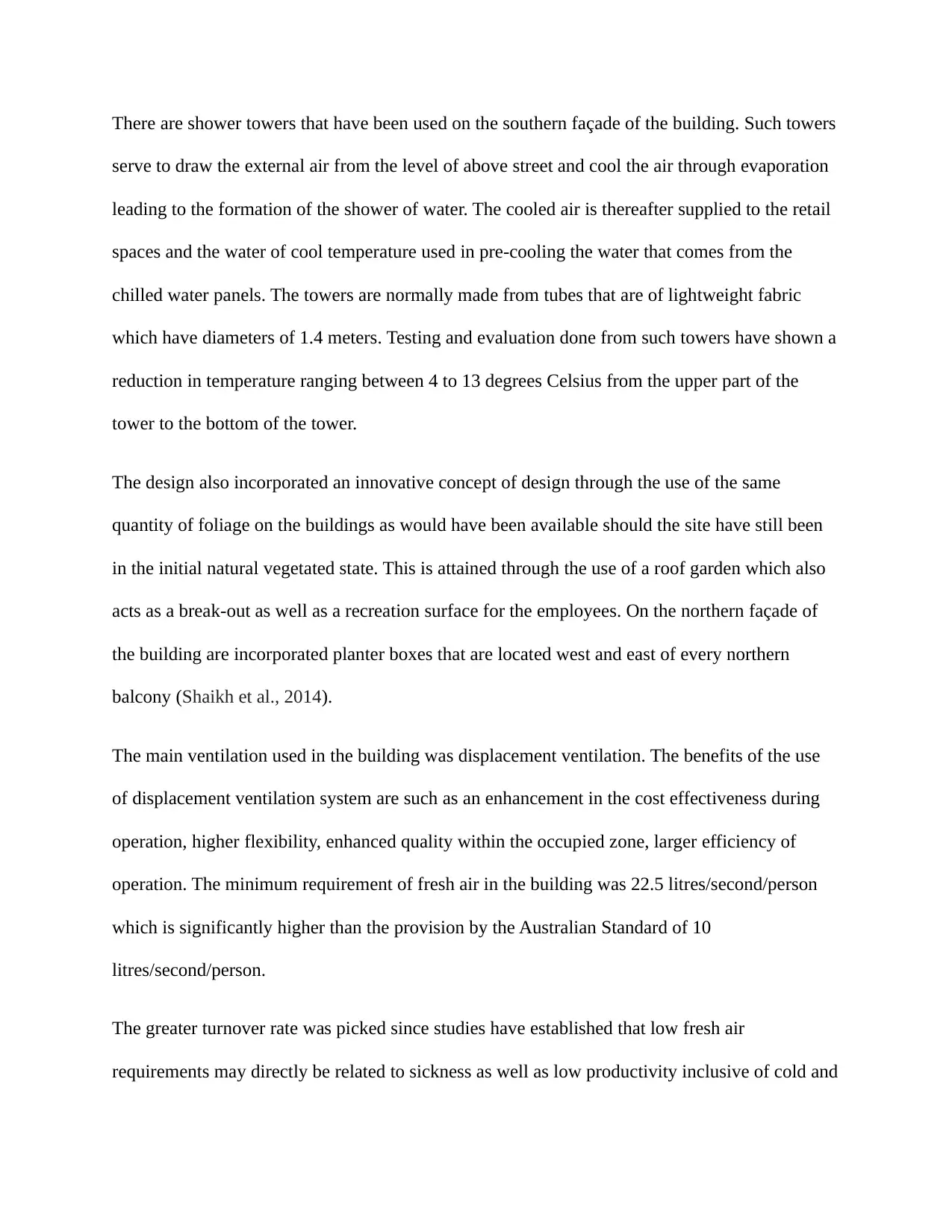
There are shower towers that have been used on the southern façade of the building. Such towers
serve to draw the external air from the level of above street and cool the air through evaporation
leading to the formation of the shower of water. The cooled air is thereafter supplied to the retail
spaces and the water of cool temperature used in pre-cooling the water that comes from the
chilled water panels. The towers are normally made from tubes that are of lightweight fabric
which have diameters of 1.4 meters. Testing and evaluation done from such towers have shown a
reduction in temperature ranging between 4 to 13 degrees Celsius from the upper part of the
tower to the bottom of the tower.
The design also incorporated an innovative concept of design through the use of the same
quantity of foliage on the buildings as would have been available should the site have still been
in the initial natural vegetated state. This is attained through the use of a roof garden which also
acts as a break-out as well as a recreation surface for the employees. On the northern façade of
the building are incorporated planter boxes that are located west and east of every northern
balcony (Shaikh et al., 2014).
The main ventilation used in the building was displacement ventilation. The benefits of the use
of displacement ventilation system are such as an enhancement in the cost effectiveness during
operation, higher flexibility, enhanced quality within the occupied zone, larger efficiency of
operation. The minimum requirement of fresh air in the building was 22.5 litres/second/person
which is significantly higher than the provision by the Australian Standard of 10
litres/second/person.
The greater turnover rate was picked since studies have established that low fresh air
requirements may directly be related to sickness as well as low productivity inclusive of cold and
serve to draw the external air from the level of above street and cool the air through evaporation
leading to the formation of the shower of water. The cooled air is thereafter supplied to the retail
spaces and the water of cool temperature used in pre-cooling the water that comes from the
chilled water panels. The towers are normally made from tubes that are of lightweight fabric
which have diameters of 1.4 meters. Testing and evaluation done from such towers have shown a
reduction in temperature ranging between 4 to 13 degrees Celsius from the upper part of the
tower to the bottom of the tower.
The design also incorporated an innovative concept of design through the use of the same
quantity of foliage on the buildings as would have been available should the site have still been
in the initial natural vegetated state. This is attained through the use of a roof garden which also
acts as a break-out as well as a recreation surface for the employees. On the northern façade of
the building are incorporated planter boxes that are located west and east of every northern
balcony (Shaikh et al., 2014).
The main ventilation used in the building was displacement ventilation. The benefits of the use
of displacement ventilation system are such as an enhancement in the cost effectiveness during
operation, higher flexibility, enhanced quality within the occupied zone, larger efficiency of
operation. The minimum requirement of fresh air in the building was 22.5 litres/second/person
which is significantly higher than the provision by the Australian Standard of 10
litres/second/person.
The greater turnover rate was picked since studies have established that low fresh air
requirements may directly be related to sickness as well as low productivity inclusive of cold and
⊘ This is a preview!⊘
Do you want full access?
Subscribe today to unlock all pages.

Trusted by 1+ million students worldwide
1 out of 17
Related Documents
Your All-in-One AI-Powered Toolkit for Academic Success.
+13062052269
info@desklib.com
Available 24*7 on WhatsApp / Email
![[object Object]](/_next/static/media/star-bottom.7253800d.svg)
Unlock your academic potential
Copyright © 2020–2025 A2Z Services. All Rights Reserved. Developed and managed by ZUCOL.





